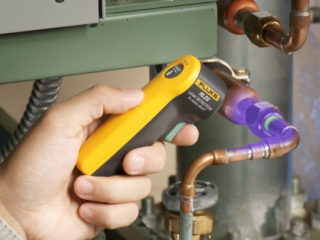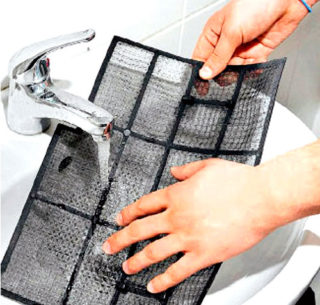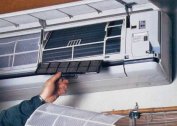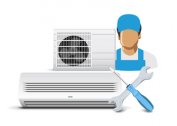More recently, air conditioning was a complex and costly procedure - the technical imperfection of the systems affected. Climatic installations were an industrial attribute; they were extremely rare in everyday life. The development of technology has dramatically changed the picture, and now air conditioning is equally common in cafes and shops, apartments and cottages, offices and hospitals.
This prevalence sharply outlined the conditions for the development of a climate equipment service network, since the repair of industrial air conditioners supplemented the repair of household ones. The service is well developed, but often users are faced with the need for self-troubleshooting for reasons of time saving. It is important to correctly assess your strength and clearly understand what you can do yourself, and where you need a trained repairman. To do this, it is necessary to present in general terms the principle of operation of technology and its classification system.
The device and layout diagrams of the air conditioner
Air conditioning has much in common with a refrigerator (or with a heat pump). The difference in the design of individual nodes and some specific details. The principle of action in all cases remains the same.
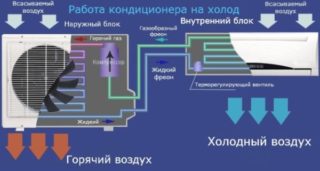 A portion of a readily volatile substance, a refrigerant, enters the evaporator. The compressor creates a vacuum in the evaporator, causing the refrigerant to evaporate, cooling the system. The cooler collects in the condenser, already with the release of heat. To distribute the resulting cold and dissipate excess heat, two fans are provided.
A portion of a readily volatile substance, a refrigerant, enters the evaporator. The compressor creates a vacuum in the evaporator, causing the refrigerant to evaporate, cooling the system. The cooler collects in the condenser, already with the release of heat. To distribute the resulting cold and dissipate excess heat, two fans are provided.
In some designs, four-way valves are installed that switch the direction of refrigerant flow. When the evaporator with condenser is interchanged, the system starts to work on heating. It is important to understand that an air conditioner cannot become a full-fledged heater - it is able to utilize low-calorie heat as long as there is a temperature gradient between the environment and the evaporator. The lower the outside temperature, the more helpless the air conditioner becomes like a heater. It is more efficient to use it as ventilation, so many models have air cleaning and filtration units.
According to the type of layout of the nodes, all models are divided into two types:
- Monoblock. The evaporator and condenser are located in one housing. According to this scheme, the window air conditioner is designed. Design advantage: simplicity, cheapness, simple installation and reliability. Repair of mobile air conditioners is required at times less often than separate systems. Of the disadvantages - high noise.
- Split system Due to the high noise level, monoblock structures began to be divided into two blocks - condenser and evaporative. The evaporative part is placed indoors, and the condenser part, as the noisiest, is outside the room. Both units are connected by tubes and electric wires. Advantages - silence. The disadvantage is the complexity of installation.
All climatic equipment is divided by type of specialization:
- Domestic. Designed for small rooms. Several options. Split system implies a wall option. Monoblocks - window and floor. A good option for an apartment or a small cottage, office.
- Commercial. Designed for a vast area: a large cottage or cafe, office, public building. The main difference from household is power and a greater variety of performance. Duct: the flow of chilled air is distributed through the duct system, and the cooler itself is hidden from prying eyes.Cassette: a segment of a false ceiling, can carry out spot conditioning. There are other options.
- Industrial. Some neglect of external design and focus on quality indicators. Works on large areas and volumes. There are a lot of options. The columned air conditioner forms a convection stream with a radius of ten meters or more. Multizone can with great accuracy create a different microclimate in predetermined areas.
All installations work the same way, regardless of whether it is an apartment or an office option. The diagnostic and repair algorithm is approximately the same.
The main types of problems and their diagnosis
The causes of malfunctions, as well as their symptoms, can vary greatly. Conditionally, problems can be divided into three main categories:
- Decreased performance or overall system outages leading to malfunctioning.
- Mechanical malfunctions.
- Damage to the electrical part.
The two main causes of reduced productivity are: Freon leakage due to a leak in the circuit, or inadequate maintenance - dust contamination of the filters and radiators of the evaporator or condenser. The chance of repairing the system yourself is very low.
If the air conditioner rarely turns off and works with a clear overload, consuming a lot of electricity, the problem is most likely in pollution. Especially if there is an unpleasant smell of burnt dust. In this case, repair of split systems is quite simple: thorough cleaning is needed.
When repairing an air conditioner, there are several important rules:
- All manipulations can be carried out after the device has been de-energized and made sure that there is no voltage.
- No brute physical force. Most models require a minimum tool to disassemble. Almost all fastenings on latches and tides, so they are removed simply by hand.
- If there is no understanding and self-confidence, it is not worth repairing a household air conditioner yourself. It is better to call a wizard who can fix the system without loss.
Lack of service
In the indoor unit remove the filters that are behind the external panel. They are washed in warm water with the addition of non-aggressive detergents, for example, ordinary liquid soap. It is recommended that you consult the manual first.
When cleaning the fan and fins of the evaporator radiator, you need to be careful - the plates are very thin and soft, they are easy to damage. You can wash it with a very soft brush in warm water with the addition of special detergents. It is convenient to use a steam generator to remove the accumulation of dust inside the air conditioner.
By the same principle, the external block of the split system is washed.
If cleaning does not help or the air conditioner starts to hum too loudly during operation, check for refrigerant leaks. This is done with a special pressure gauge with the fan and compressor running. The absence of a given pressure in the system indicates leakage and deficiency of freon.
First look for a leak. Two main ways:
- they fill the system with nitrogen and a gas analyzer finds where the line has been depressurized;
- if the manufacturer has added a special indicator glowing in ultraviolet light to freon, lamps of the necessary spectrum are used.
After elimination of the violation in the highway, the system is filled again with freon. This should be entrusted to a specialist, otherwise the cost of repairing an air conditioner can grow at times.
Mechanics
The main mechanical failure is expressed by the appearance of condensation. Since the relative humidity of cold and warm air varies, condensation is inevitable. For its removal there is a special drainage tube. If water begins to appear in the room, check the discharge hose.In winter, clogging may occur due to ice plugs. Installation of a special heating circuit will help.
In summer, dust, fluff, insects can become a cause of blockage. Blowing with compressed air helps. A bicycle pump will be enough.
Electrical part
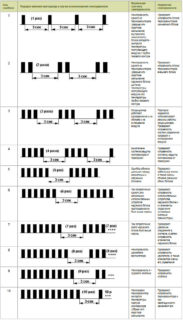 If the remote control does not work, but the air conditioner responds to commands from the panel, check the quality of the batteries. If the system crashes without the participation of the remote control, you need to check the parameters of the mains. If the voltage in the outlet does not match the rating, or there are surges, they can cause malfunctions. Output: install a surge protector and uninterruptible power supply.
If the remote control does not work, but the air conditioner responds to commands from the panel, check the quality of the batteries. If the system crashes without the participation of the remote control, you need to check the parameters of the mains. If the voltage in the outlet does not match the rating, or there are surges, they can cause malfunctions. Output: install a surge protector and uninterruptible power supply.
Most air conditioners are equipped with a warning system. In case of basic typical malfunctions, they are signaled by a blinking LED with a certain frequency and frequency. Any error has its own code. Approximate decoding of signals by the number of blinks:
- 1 - malfunction of the thermistor of the indoor unit.
- 2 - requires replacement of the outdoor block thermistor.
- 3 - the circuits simultaneously operate both for heating and cooling. The main reason is a malfunction of the switching relay or tap.
- 4 - overload protection lock.
- 5 - lack of information communication between the blocks.
- 6 - power consumption is above normal, power transistors should be checked.
- 7 - dangerously high voltage in the outdoor unit.
- 8 - fan drive is faulty.
- 9 - the valve responsible for changing the heating-cooling mode does not work.
- 10 - there is no temperature control on the outer wall of the compressor. It is necessary to check the thermistor.
Troubleshooting
Failure prevention begins at the stage of equipment selection and installation: it is important to follow all the manufacturer's recommendations. No need to force the air conditioner to do what it is not adapted to. For example, to heat an apartment at sub-zero temperatures.
Pay attention to electricity. If there are jumps and drops on the network, a filter and a UPS are required. The presence of grounding is also necessary - even static voltage on the case can cause a malfunction of the electronics.
Observe the frequency of cleaning the filters. A clean filter is the clean air that users breathe.
